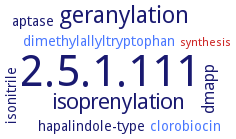2.5.1.111: 4-hydroxyphenylpyruvate 3-dimethylallyltransferase
This is an abbreviated version!
For detailed information about 4-hydroxyphenylpyruvate 3-dimethylallyltransferase, go to the full flat file.

Word Map on EC 2.5.1.111 
-
2.5.1.111
-
geranylation
-
isoprenylation
-
dmapp
-
dimethylallyltryptophan
-
clorobiocin
-
isonitrile
-
hapalindole-type
-
aptase
-
synthesis
- 2.5.1.111
-
geranylation
-
isoprenylation
-
dmapp
- dimethylallyltryptophan
- clorobiocin
-
isonitrile
-
hapalindole-type
-
aptase
- synthesis
Reaction
Synonyms
4HPP dimethylallyltransferase, apT, aromatic prenyltransferase, CloQ, FamD1, isoprenyl transferase, NovQ
ECTree
Advanced search results
Crystallization
Crystallization on EC 2.5.1.111 - 4-hydroxyphenylpyruvate 3-dimethylallyltransferase
Please wait a moment until all data is loaded. This message will disappear when all data is loaded.
sitting drop vapor diffusion method, using 1.0 M sodium citrate, 0.1 M imidazole, pH 8.0
crystals are grown by hanging-drop vapor diffusion at 20 °C. Structure of of the apoenzyme, of CloQ complexed with 4-hydroxyphenylpyruvate, of mutant enzyme C215S complexed with 4-hydroxyphenylpyruvate and of the mutant enzyme R66S complexed with 4-hydroxyphenylpyruvate. Structure of CloQ complexed with 4-hydroxyphenylpyruvate reveals the formation of a covalent link between the substrate and Cys215 to yield a thiohemiketal species
crystals are grown by vapour diffusion. The protein crystallizes in space group I4(1)22, with unit-cell parameters a = b = 135.19, c = 98.13 A. Native data from a single crystal are recorded to a resolution of 2.2 A in-house
molecular mechanics and hybrid quantum mechanics/molecular mechanics molecular dynamics simulations. Positively charged basic residues line the inside of the beta-barrel of CloQ to activate the diphosphate leaving group to replace the function of the Mg(2+) cofactor in other APTases. The effect of the replacement of the Mg(2+) cofactor with basic residues yields a similar activation barrier for prenylation to Mg(2+)-dependent APTases like NphB. The topology of the binding pocket for 4-hydroxyphenylpyruvate is important for selective prenylation at the ortho position of the ring. Methylation at this position alters the conformation of the substrate for O-prenylation at the phenol group


 results (
results ( results (
results ( top
top





